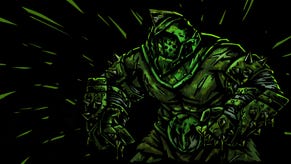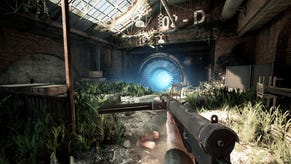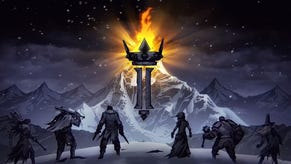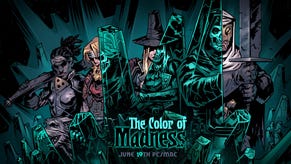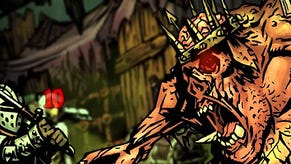Darkest Dungeon PC Review: Circle in the Dark
Terror may indeed stalk these shadows, but yonder - a glint of gold.
This article first appeared on USgamer, a partner publication of VG247. Some content, such as this article, has been migrated to VG247 for posterity after USgamer's closure - but it has not been edited or further vetted by the VG247 team.
The first time you lose a character in Darkest Dungeon, you will feel a powerful urge to start a new game. My advice? Don't. There's a long road ahead, and it will be paved with the bones of your party members.
Learning to accept death as a setback and not total failure is the first step on the road to success in Red Hook Studios' new roguelike, which left Early Access earlier this week. Your party members will inevitably run afoul of the RNG gods and perish, or they will go mad and you'll have to cut them loose. If you hold on too tight, you will eventually go broke, with only a weak party to show for it. Natural selection is in full force in Darkest Dungeon.
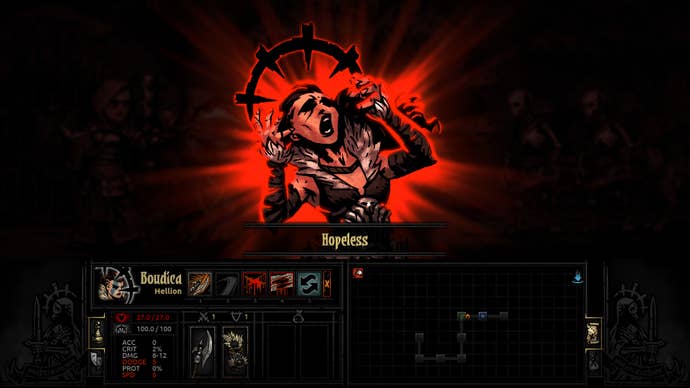
In that, Darkest Dungeon differs from the traditional roguelike. While they share many similarities - permanent death, random dungeons, objects that can help or hurt your party - death does not mean game over in Darkest Dungeon. Even if you lose a max level character and their accompanying trinkets, it's possible to pick yourself up and keep going - necessary even given that you can't just reload your saved game. You'll only get a game over in Darkest Dungeon's accompanying New Game Plus, should you get that far.
Once you accept Darkest Dungeon's first and most basic truth, you will find yourself having a much better time with what is an unforgiving game. Hard as it is, though, I find that I keep going back, clinging to every small victory. I'm drawn not just by its outstanding presentation and its fantastic gameplay depth, but the sheer challenge. It's the K2 of RPGs.
At its heart, Darkest Dungeon is basically an extended dungeon crawl. There is a story, but it's quite limited, the majority of the narrative being conveyed through the narrator's haunting descriptions of how everything went wrong and horrors were unleashed on the world. The core of the game is in recruiting party members from the Stagecoach, sending them down into the deep, and hoping that they come back stronger for it. There are four dungeons to explore, each of which requires its own specific strategy, with a fifth - the titular Darkest Dungeon - representing the endgame.

What keeps things feeling fresh is the sense of danger around every corner. You're always just one step from running into a particularly powerful enemy at just the wrong time, or from a few ill-timed critical hits wrecking one of your key party members and sending them over the edge. The palpable tension that results makes every run an adventure in itself, and in turn makes victory all the sweeter.
That said, it can still be a grind at times. If you're more interested in an epic narrative than party compositions and gameplay systems, Darkest Dungeon probably isn't for you. It's a game that depends heavily on its systems for its appeal, which puts it into a category shared by hardcore roguelikes. It demands perserverance, strategic thinking, and above all, patience.
But what it does well, it does really well. Some might even say brilliantly. I haven't had this much fun playing a hardcore dungeon crawler in a very long time.
In the Dungeons of Madness
Of course, I'm a sucker for any game that makes you think about turn-based tactics and party composition. I can spend hours obsessing over optimal party combinations and skill builds. It's how Pokémon managed to hold my attention for as long as it did.
Darkest Dungeon obviously can't match the insane number of party combinations offered by Pokémon; but with 14 types of heroes to choose from, there is no shortage of options. What's more, Darkest Dungeon strongly encourages you to experiment with different combinations by making it difficult, if not impossible, to assemble a single "A Team" that can take on any dungeon. Certain characters perform particularly well in certain dungeons, with the status effect-driven Plague Doctor thriving in The Cove- where sea monsters have tough hides but are vulnerable to status effects - and the Crusader and the Vestal doing particularly well in the undead-heavy Ruins. In that, Darkest Dungeon almost never becomes rote or boring, despite its strong reliance on repetitive dungeon diving.
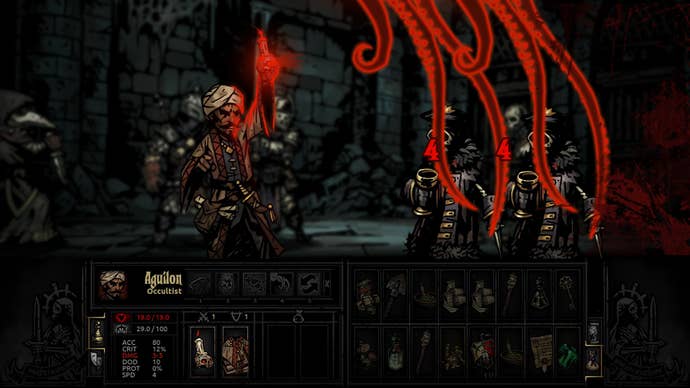
The classes options range from the familiar to the esoteric, with all of them filling a particular niche in the party. The Occultist feels like an odd fit at first, but his powerful back rank attacks and marking abilities make him a great support character. The Abomination, meanwhile, provides pure offense with his beast mode abilities, but at the expense of driving up your party's stress level. Further complicating matters is the fact that religious characters like the Crusader will refuse to travel with the Abomination at all, forcing you to think hard about what sacrifices you're willing to make for power.
Taken together, Darkest Dungeon's characters comprise a motley but entertaining crew - a Star Wars cantina's worth of scum and villainy. They're all fun in their own right; and while the Jester in particular lags a bit behind the rest, they all have the ability to fill a particular niche in a party. If dungeon crawling is Darkest Dungeon's heart, then its characters are its soul.
Inevitably, you will become attached to certain characters, particularly the ones who do well for you early on. The nature of Darkest Dungeon's systems, though, make learning to let go a necessity. As they progress, characters will sometimes pile up negative personality traits that are too expensive to cure and too debilitating to ignore, making them a liability. Or their stress gauge - essentially a second life bar - will max out during a run and they will become selfish or masochistic, forcing you to weigh whether to spend the money to reduce their stress at the local tavern or simply release them. With money being needed to upgrade weapons and buy supplies like food, bandages, and torches before a run, it's sometimes better to just move on.
There are times when Darkest Dungeon's surfeit of systems can feel overwhelming. When your best party members are too stressed out to go adventuring, your roster is full, and your remaining characters are weaklings, it can be difficult to decide what to do next. Usually, though, you just have to suck it up, be ready for some short-term pain in favor long-term gain, and keep upgrading the Stagecoach so you can get more and more characters.
The flipside of all that is the deep sense of accomplishment that accompanies mastering all of Darkest Dungeon's myriad systems. There's nothing quite like running a high-quality party loaded up with the best personality traits and items. It makes you feel capable to taking on even the most powerful eldritch abominations, of which there are no shortage in Darkest Dungeon.
Venture Forth
Admittedly, there have been times where I've wondered whether its worth it to press on toward the endgame. It really is a grind in the truest sense of the word, the ultimate goal being to get multiple parties maxed out so that they can take on the endgame.
Veteran dungeons - which appear once you start getting characters to level three - are a rude awakening after cruising through the Apprentice-level areas. Your best party won't be nearly ready to tackle Veteran-level dungeons when you first open them up, forcing you to continue hitting Apprentice dungeons until you get enough items to upgrade your Blacksmith and open up higher level weapons and armor. Getting to the point where you can reliably tackle Veteran-level dungeons takes a lot of patience, and I expect a lot of players will quit before they get to that point.
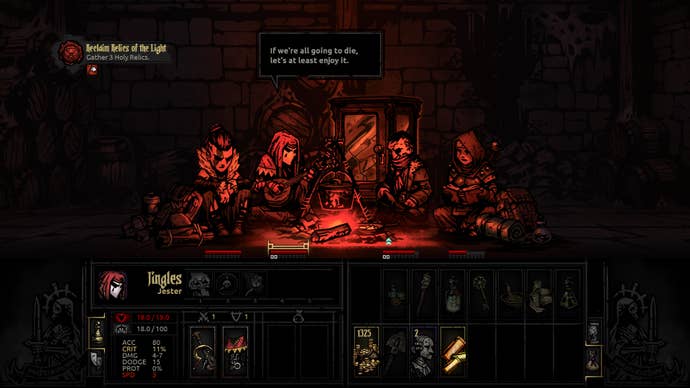
Exacerbating the massive leap in difficulty from Apprentice to Veteran is the fact that you need certain items to upgrade certain buildings, some of which are difficult to find reliably. Deeds - which can only be obtained reliably from The Weald - are an especially notable bottleneck, as they are required to upgrade both the Stagecoach and the Blacksmith. Obtaining enough Deeds to advance is a long road, to say the least.
Once you do hit Veteran level, you will find that Darkest Dungeon relies heavily on recycled content. Having defeated the Apprentice Necromancer, you will have to fight the Necromancer - essentially the same boss with better stats and more sophisticated A.I. It helps, of course, that these bosses are all look fantastically cool to look at and fun to fight - or just plain gross, as in the case of the Inchoate Flesh, which I wound up dubbing "Melty Pig." But it's ultimately a bit of a downer that the Veteran and Champion-level dungeons don't have new bosses of their own.
So what keeps me playing, then? A lot of things, to be honest. I've got the short-term goal of leveling up my Blacksmith and making enough money to outfit a top-quality party. I've got the endgame to look forward to. But what really keeps me coming back is the rich and diverse cast, the huge number of interesting systems - some of which I haven't even managed to cover in this review, like camping - and the sheer excellence of its presentation.
Of course, hardcore RPG fans will tell you that graphics don't matter; and to some extent, I think that's true. But Darkest Dungeon makes the case for a great presentation being able to set a game's tone in a way that makes it stand out from everything else. So much of what makes Darkest Dungeon memorable is bound up in its dark music, its Lovecraftian monsters, and its narrator intoning after a victory, "Remind yourself that overconfidence is a slow and insidious killer." Darkest Dungeon's systems are outstanding, but its presentation is what takes it to another level.
So while I've occasionally grown frustrated with Darkest Dungeon's grind, I've always found myself coming back. There's always just one more run to undertake, one more boss to kill, and one more broken and gibbering soul to send into oblivion. I'm in this for the long haul.
InterfaceDarkest Dungeon's point-and-click interface is speedy and reasonably easy to understand. Outside of the somewhat confusing Resolve level, which governs how much stress a character accrues in a dungeon, the systems are well-presented and easy to grasp.
Lasting AppealIt's pretty easy to rack up between 50 and 100 hours in Darkest Dungeon, with some going as high as 1500 hours (no, really). It's a grind, but the constant danger that accompanies every run keeps it from being rote and boring.
SoundThe narrator is brilliant and menacing in an over-the-top sort of way, and the music does a great job of setting the mood. This is a game you definitely want to play while wearing headphones.
VisualsDarkest Dungeon is stylish and brimming with personality. Its monsters are menacing, and its bosses are huge and terrifying. You look at this game and understand why your party is constantly on the verge of madness. In short, it's great.
ConclusionI can't say enough nice things about Darkest Dungeon. Its presentation is brilliant, its systems are smart and well-constructed, and it does a lot to subvert what we should expect from the average dungeon crawler. For a game built around slowly grinding up multiple parties of adventurers, it's remarkable how fresh it can feel even after more than 50 hours. It's only January, but Darkest Dungeon is already one of my favorite games of the year.



